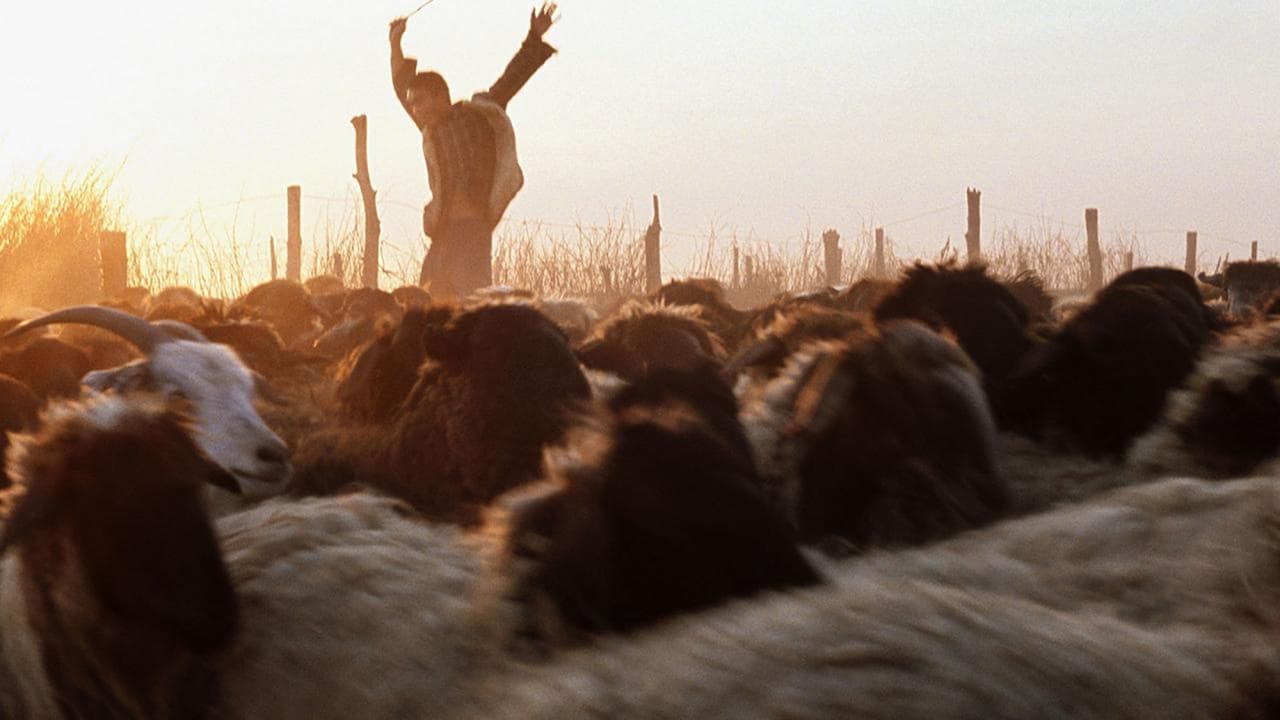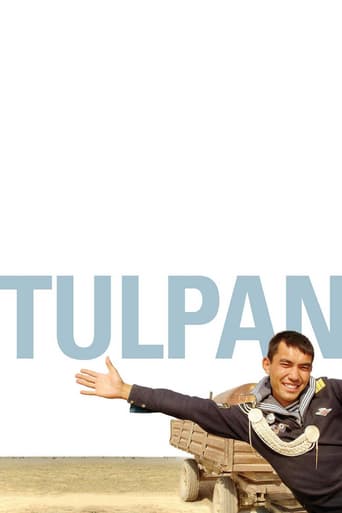

After a long time saw a movie that made me feel like floating in a different realm of dreams. It's so realistic yet fascinating. Without showing the Tulpan in person the story builds around hope, failure, dreams so artfully! I wished this movie to be longer. And add on to that the beautiful songs sang by the kid and her mother, deserts have millions of stories to tell. May be its just a particle of sand that got drifted to we viewers through Sergei's lens. Still i believe Tulpan's character could have been introduced with more touch points so that the strength of the plot would have been more touchy. Asa faced very few challenges in the story to signify the importance of Tulpan in his life. It's a beautiful movie, its just that i'm still greedy for a lengthier version of it.
... View MoreTulpan (2008) was directed and co-written by Sergei Dvortsevoy. This film was co- produced in five different countries, but filmed primarily on the Central Asian steppes of Kazakhstan. The movie is basically about unrequited love, but it has the feel of a documentary. (Tulpan is one of those movies where the first thing you do when you return home is to check out its country of origin in Wikipedia!)Boiled down to basics, the film is about Asa, who has returned home to Kazakhstan after serving in the Russian navy. Now he wants to find a wife and settle down to the nomadic life style that apparently still exists in this harsh and unforgiving landscape.Asa loves the beautiful Tulpan, whom he has barely glimpsed and we never see. While he is courting her he lives with his sister, her husband, and their three children. Asa apparently was a good sailor, but he's not really adept at the skills needed for life on the steppes. His brother-in-law wants him to leave, his sister wants him to stay, and Asa can't decide what he wants to do, or even what he'll be able to do.I know very little about life lived in a yurt on the Asian grasslands. As this life is portrayed in the movie, it's not meant for dreamers or amateurs. People speak of the harsh beauty of the landscape, but I don't see it. (Well, I see the harsh part, but not the beauty. To me it looks cold, dusty, dry, windy, and forbidding.) Our species is very adaptable, and it's no surprise that a lifestyle has evolved that allows humans to survive in this environment. Whether Asa will choose that lifestyle, and whether he will survive it if he does choose it, are at the heart of the plot.At the heart of the movie are the images of the Steppes of Central Asia, and the few rugged people who live there.
... View MoreKazakhstan is one of those dusty Central Asian countries left over from the break-up of the Soviet Empire and probably best known in the West as the putative birthplace of Sasha Baron Cohen's media clown Borat. In this film the documentary filmmaker Sergei Dvortsevoy goes some distance toward giving us westerners a taste of real life amongst shepherds on the steppe. Fresh out of the Russian navy submarine service, Asi goes to stay with his sister Samal and her sheep herdsman husband Ondas. Despite the isolation, wind, dust and extreme temperatures, Asi dreams of having his own flock and settling down. But Ondas refuses to help him with the flock until he finds a wife, for a single man cannot be a herdsman. The film opens with Ondas negotiating to marry Asi off to Tulpan, the daughter of a neighbour, but Tulpan, who remains behind a curtain and is never actually seen, rejects him – "His ears are too big". Asi tries again, alas to no avail.This plot is really secondary to an account of what it is like to live and work in a place like this. Ondas's lambs keep dying and the vet is called (how is a mystery). He diagnoses lack of feed, so the family must pack up its Yurt and move elsewhere. Much comedy is provided by a young injured camel being transported in the vet's sidecar, followed by the camel's mother which bites anyone who gets too close. Ondas and Samal's three children also provide plenty of entertainment. The oldest girl sings a mournful folksong all the time, the older boy recites entire news bulletins learned from the portable radio he keeps with him, and the younger boy is just plain cute. Asi's tractor driver friend, with his collection of pin-ups in his cab, also provides some amusement.Life on the steppe is tough, but brings with it a certain amount of freedom. Modernity, in the form of the official news bulletins, parodies of the official style, is at a good distance away. The sheep flocks are big enough to provide a living as long as there is a demand for their wool. Ondas, a proud tough man, would not be happy living in a town. Samal might, though. Dvortsevoy does not idealise his characters and they are all the more appealing. However, I can't see the steppes becoming a tourist destination except for some very hardy travellers.
... View MoreWhat does a young Kazakh man like Asa (Askhat Kuchencherekov) do when he leaves the Russian navy? He looks for a bride and plans to settle down to a life of herding sheep on the Hungersteppe (Betpak Dala) of Kazakhstan. The only available bride is Tulpan who he sets out to woo. He resists his friend Boni's attempts to get him to head for the cities.Kazakh documentary maker Sergey Dvortsevoy has brought us the acclaimed feature film Tulpan. Its flat, dusty, dry plains are reminiscent of parts of outback Australia but are even more remote. The movie was shot 500 km from the nearest city Chimkent. It is harsh and unforgiving with powerful dust storms dominating the environment.Most of the interior scenes take place in traditional tent houses called jurtes. The family is close in every sense of the word. Asa's sister Samal (Samal Esljamova) and Ondas (Ondas Besikbasov) and their three children share their home with him. Some of the most touching scenes involve singing within the intimacy of the family group.The tiny domestic space is not the only cause of tension. Ondas is particularly tough on his brother-in-law Asa, perhaps because of the incredibly strong bonds between brother and sister.Like the lives of the local people, the making of the film revolved around and evolved with the lives of the sheep. Dvortsevoy explains on the official website:"The crew spent two weeks just following sheep. In the third week, we tried several times on video to understand what camera movements should be used when the sheep is giving birth. Once the camera crew was technically ready, we waited for one of the thousands of sheep to give birth. The shepherd had a radio station and would call us as soon as one was ready.When the scenes were shot, I understood that they are so unique and powerful that I had to adjust the rest of the film to those scenes rather than adjusting them to the script. From that on we opened the film to the experiences we made in everyday life and let them influence the story-building. In the end the film grew like a tree and many things were unpredictable." The karakul sheep from Central Asia have been controversial: "... it could refer to the fur of newborn Persian or karakul lambs or it could refer to broadtail fur taken from fetal lambs (or generally refer to both)—but whatever its exact definition, astrakhan boils down to one thing: early death for lambs, often even death for fetal lambs and their mothers." 'Astrakhan: Hot "New" Fashion is the Same Old Cruelty'The birth scene is the most gripping moment of the story. The website has a full explanation.One small criticism: the shaky hand-held camera work was sometimes unnecessarily distracting.It's easy to see why Tulpan has been hot at the film festivals. Superlatives are hard to avoid: original, raw, authentic, genuine, funny, joyous, honest.Dvortsevoy has restored respectability to the term reality. In fact it is hard not to think that this is a documentary at times. These people couldn't really be actors. It's great to see the potential of the movie medium stretched in such powerful ways.Cinema Takes: http://cinematakes.blogspot.com/
... View More